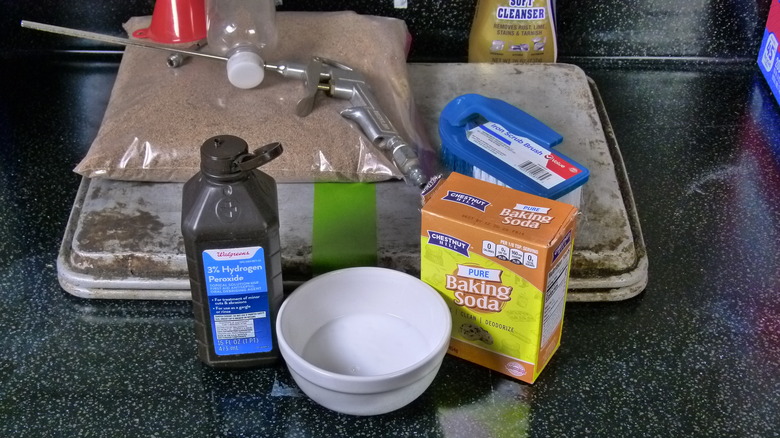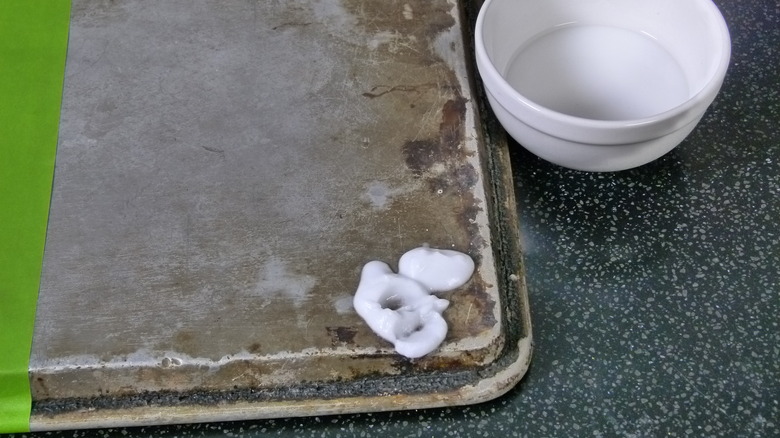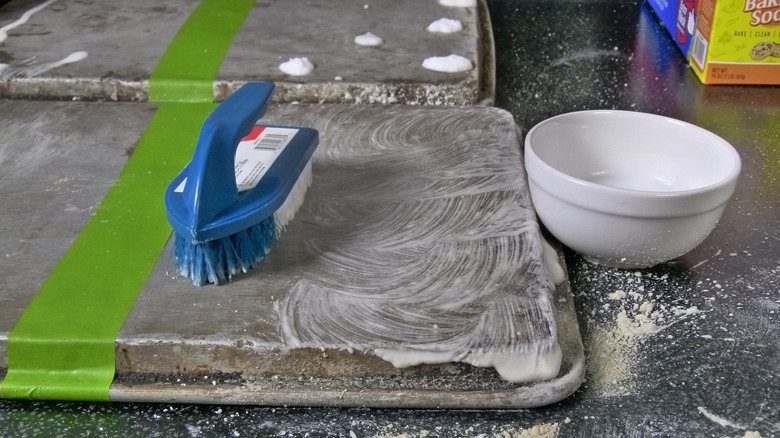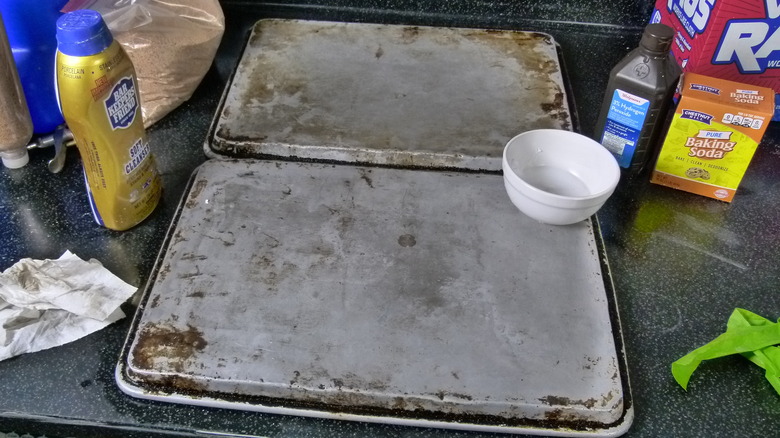We Blasted Old Baking Sheets With Hydrogen Peroxide & Baking Soda: Did They Sparkle?
Baking sheets are the worst. Your favorite and least favorite, cheapest and most expensive, flattest and most twisty all end up in more or less the same state: blackened with baked-on ... something. Carbon? Desiccated grease fused with steel? Whatever the stuff is, it won't come off and everyone knows it. Yet we've seen writers, home improvement influencers, trendy product contrarians, and others claim that the way to get your baking sheet back into good working order is with a paste of hydrogen peroxide and baking soda. For that matter, we've made the claim that this magic paste can bring life back to your well-loved baking sheets ourselves. So we thought it was time to put the idea to the test.
Note that we said "good working order." Baking sheets take a lot of abuse, and it's virtually impossible to return one to factory condition, because of the scratches if nothing else. We hoped to return some of the surface to something like its original color and if possible, finish, but no one was holding their breath. Furthermore, your average TikTok influencer isn't about to take on the scrubbing challenge we had in store for ourselves.
Bringing peroxide to a peroxide fight
We had everything we needed on hand, including hydrogen peroxide (currently $1.00), baking soda ($3.14), and a new scrub brush we used for all tests. The important thing with regard to the brush was to use the same one, and the same force, across both tests. The second test made use of Bar Keeper's Friend Soft Cleanser ($2.72), a citrus version of the more abrasive classic.
At the beginning of the pandemic, we acquired a bunch of commercial cooking equipment from a local home-style restaurant that was shutting its doors for good. Among these bits and bobs were a large number of full- and half-sheet baking pans. Given their tenure in a home-cooking restaurant, these were not in terrible condition. Nor were the kind of thing you'd bring out when the in-laws are in the house. After years of commercial dishwashing and some earnest attempts of our own to clean them up, it looked unlikely they'd ever be presentable again. Seems like a fair test surface for our DIY cleaner, right? No. Instead, we inverted the pans and attacked the bottoms, which — having gotten little of the attention the food surfaces received either in the restaurant or at home — were unbelievably grimy.
We did everything we could to clean the blasted things
Nothing could be simpler than scrubbing a pan. With a sandblaster. (We'll come back to that.) For our baseline tests, we soaked one side of two pans with the hydrogen peroxide/baking soda paste, and the other side of both with Bar Keeper's Friend for 15 minutes. Our original idea was to clamp a Scrub Daddy between the baking sheet and a block mounted in a drill press to ensure that we applied equal pressure each time we scrubbed. For various reasons, this quickly turned into a nightmare. The scrubber wouldn't stay in place, and no amount of pressure seemed to make much difference until we reached the point of tearing the scrubber apart. You also get the best results by periodically submerging a Scrub Daddy in a bowl of ice water, which is not easily accomplished in our workshop. So we just decided to apply as much pressure as we could to a brush, keeping the tips of the bristles in contact with the pan. This seems both fair and the most anyone at home was likely to do.
For reasons we'll come to, we also sandblasted the cleaned pans to see if it would remove any remaining whatever-it-is from the half-sheets. Instead of sand, which we were not equipped to use, we blasted with crushed walnut shells from Harbor Freight ($27.99 for 25 pounds). We used this medium in a homemade sandblasting rig at about 110 psi.
Hydrogen peroxide (and baking soda) wins
Perhaps it's an acknowledgment of our failings, or maybe an innate sense of fairness, but product tests tend to have results that fall somewhere short of conclusive. Without university funding and stuff like autoclaves and graduate students, there's always some way you could have done it better, and it should always be acknowledged. This is not one of those times. The peroxide/baking soda paste clearly outperformed Bar Keeper's Friend handily on both pans. What's more, the sandblasting didn't do much to improve the state of the baking pans, which suggests you're really not going to do much better without an abrasive blast cabinet and something like aluminum oxide as the blasting medium (and since you probably won't do that, there's no reason for us to).
However, overall the results were not spectacular ... but no one expected them to be. In the spirit of full disclosure, we've performed a similar test using peroxide and baking soda before, as a comparison when testing Pink Stuff cleaner. The results were about the same here, and they exceeded our expectations slightly. The thing is, whenever something exceeds your expectations even a little, it's a success, whether or not it's actually 100% successful. There's a reason to do it; it works as well as you could reasonably hope; and you'd do it again. We call that a win.



